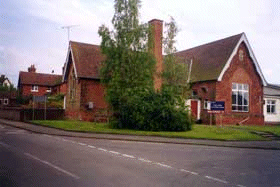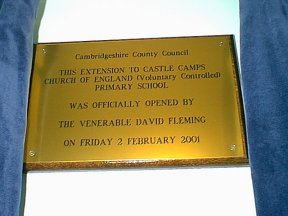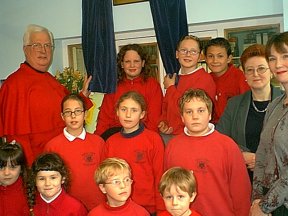 |
 |
An unlicensed Schoolmaster was teaching in Castle Camps in 1579, but no regular school was recorded until 19th Century, though 30 children were being taught in 1728.
A Sunday School held at the Church by 1807 had 70 pupils in 1818.
Benjamin Keene's wife Mary in 1818, and Keene himself in 1836, supported a school for 26 girls, while the Rector in 1818 maintained another Girls' School, which by 1833 also took paying pupils.
A third School, started after 1825, was attended in 1833 by 28 boys.
Benjamin Keene's Will, proved in 1838, left £300. which later yielded £9 a year to maintain the Church Sunday School. In the 1960s an annual amount of £7.10.0 was still being paid to that Sunday School, which had expired by 1974.
In 1846, there were two Day Schools supported by subscription and school-pence. A Master taught one with 38 pupils, which had a £25 grant from the National Society. A Mistress taught at the other with 21 pupils. They probably combined to form a Sunday School with 120 pupils attached to the National Society, and held in a building in the Churchyard.
In 1851 the Day School's average attendance was 60. The pupils were mostly very young, for most parents sent their children to work at 7 years of age, and in the 1860s few adult parishioners of the labouring class could sign their names. The Rector was sti11 financing the school in 1858.
In 1863, W.M. Collier of Camps Hall Farm gave £50 to endow the Day School, which still received £1 per year from that source in the 1960s.
In 1865 the School was re-organised as a Church of England mixed school, including an Infants' Department.
With building grants and gifts from the Charterhouse, a new Schoolroom in the Gothic style was completed at Camps Green (now Castle Camps) in 1866, the older one being left for the Sunday School. There were then 96 pupils, paying school-pence, on the books.
In 1877 there were 120, 73 in 1882, 124 by 1888, and 153 by 1906. The Schoolroom was enlarged in 1876 and again in 1886 to accommodate 160 pupils, and a Master's House was built in 1892. Attendance declined from 107 in 1914 to 75 by the 1930s.
In 1937, the older pupils were transferred to Linton Village College, leaving 34 juniors. The surviving Day School (for Juniors) was taken over by County Council in 1960, and enlarged to take the younger children from Shudy Camps.
On Friday 2nd February 2001, the
new extension to the school was officially opened. This comprises three new classrooms, pupil toilets and cloakrooms, as well as a new IT room and Library area. Also, there is a new staff room with Reception office and Headteacher's office.
The majority of the funding has been secured via the Government's New Deal for Schools and Key Stage One initiatives. The school has funded the cost of the IT facility, with the support of the Diocese of Ely.
 The opening was attended by a selection of the parents and governors, as well
as all of the pupils. The Headmistress, Carol McIntosh welcomed everyone to the school and
introduced the guests, Councillor John Eddy, Chairman of Cambridgeshire County Council,
Councillor Ramon Wilkinson, Chairman of Education, Libraries & Heritage Committee, The Venerable David Fleming and the
Chair of Governors, Mrs Elizabeth Gladman.
The opening was attended by a selection of the parents and governors, as well
as all of the pupils. The Headmistress, Carol McIntosh welcomed everyone to the school and
introduced the guests, Councillor John Eddy, Chairman of Cambridgeshire County Council,
Councillor Ramon Wilkinson, Chairman of Education, Libraries & Heritage Committee, The Venerable David Fleming and the
Chair of Governors, Mrs Elizabeth Gladman.
The Venerable David Fleming gave an interesting talk to the children, then formally unveiled
a plaque signifying the opening. Mr Wilkinson explained to the children that it was his
job to actually hand over the new building to the governors and asked how best
he could do this. One pupil suggested that he could deliver it on a very large lorry! However, he agreed with another pupil
that the best way would be by means of a key and he produced a very large gold key from his
pocket which he presented to Mrs Gladman.
After this, the pupils gave a musical presentation to the audience and then everyone one
was invited to a very fine buffet.
Live music was provided by 'Souled Out.'
This List was last updated on 2nd February 2001.
The number of
people who've looked at this page so far is: